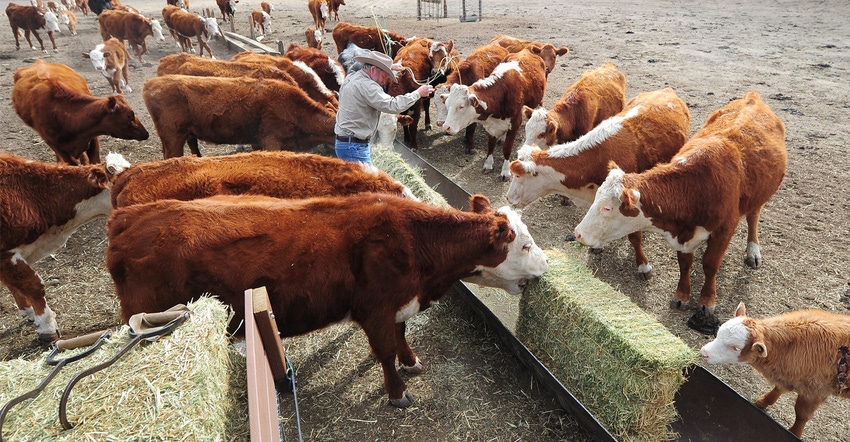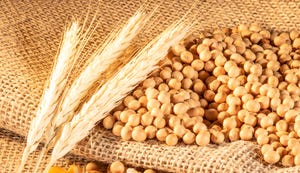
Impending drought may make things tight for cattle producers as they look to keep their herd fed, but Karl Hoppe thinks it’s time that cattle producers look outside the box and diversify their feed bunk.
Hoppe, livestock systems specialist at North Dakota State University’s Carrington Research Extension Center, says livestock producers in Northern climates are quite familiar with feeding cattle in winters and that winter feeding can be transitioned to summer feeding if necessary. He points to the experience of 40 years of year-round drylot cow herd feeding at the Carrington center.
For producers to make the research work in their own operations, they must look outside the traditional feeding program. “If we do run into a really extended drought, feeding cows with calves during the summertime in the feedlot is really nothing new,” he says, “It’s been done for a long time, and it works quite well. We just need to balance a ration accordingly to have it work.”
Energy and protein needs
Hoppe says when looking at the feed bunk, “we look at energy needs, and that’s usually where we focus on supplemental feeds to get that energy in the animals.”
Corn grains are usually the cheapest way to meet energy needs, though that may not be the case if drought conditions drive up corn prices.
Corn as an energy source can come in many different forms, Hoppe says, from the obvious grain form to earlage, silage, stover and now a variety of corn coproducts that are readily accessible.
Hoppe says cattle producers have a number of meals produced from oilseeds, many that are crushed in North Dakota. These include soybeans, canola, sunflower and linseed meal, which comes from flax. The oilseeds themselves are also good protein sources. But “if we feed too much oil, we can decrease digestibility of the seeds and cause cattle to go off feed as oils are toxic to the rumen microbes,” Hoppe warns. “A little is OK, a lot may be bad,” he adds. “Three to 4 pounds may be the limiting factor of oilseeds added to a cow’s ration.”
Other potential protein sources producers may turn to is distillers grain, as well as the often-overlooked field peas and lentils. “They are high in protein and work quite well as a protein supplement when you’re looking to add protein to our feed bunks,” Hoppe says. “Actually, if you’re feeding field peas and lentils, not only do they provide protein, but they provide quite a bit of energy, nearly similar to what corn would be, so they’re a nice alternative.”
Of course, the “queen” of forages is alfalfa, and clovers can also provide protein, but Hoppe warns to guard against sweet clover poisoning, which occurs when the hay is baled too wet.
Coproduct supplements
In addition to protein and energy, forage-rich cattle diets will also need to be supplemented with fiber, vitamins and minerals, and coproducts can often fill that bill.
Coproducts are the result of a variety of processes from ethanol, wheat milling, oil crush, sugarbeet and potato processing. Hoppe says North Dakota producers are fortunate to have all those processors within or near the state. “As you get farther away, freight becomes a problem, and the costs of that coproduct feed increases when the freight increases.”
Just an example of how much coproduct is produced in the state, Hoppe points to the State Mill and Elevator in Grand Forks that is the world’s largest durum wheat mill located in one site. Hoppe says this plant mills 90,000 bushels of wheat daily into flour or semolina, and the process also kicks out 700 tons of wheat middlings daily. Feeding at a rate of 10 pounds per day is enough to feed 140,000 cattle daily.
Wheat midds offer 18% crude protein and 83% total digestible nutrients, and are low in calcium and high in phosphorus, which is “a very nice addition to a roughage ration,” Hoppe says.
North Dakota’s wheat milling facilities, five ethanol plants, and its soybean, potato and sugarbeet plants offer producers a number of coproduct feed choices.
Hay in short supply?
Hoppe says if hay will be in short supply, it’s possible to replace hay with coproducts from these plants such as distillers grain, wheat midds, soyhulls, corn gluten feed, barley malt sprouts, beet pulp, potato byproducts and protein meals, such as from soybeans, canola, sunflower and linseed.
Grains can also replace hay in diets, with Hoppe recommending corn, barley oats, wheat, field peas, lentils and grain screenings. However, he warns of weed seeds in the screenings.
When contemplating the introduction of new feedstuffs into your herd’s ration, Hoppe says producers should consider a number of factors:
nutritional value
coproduct availability
transportation costs
storage issues
A number of studies have been conducted at the Carrington Research Extension Center on feeding coproducts to cattle.
About the Author(s)
You May Also Like






